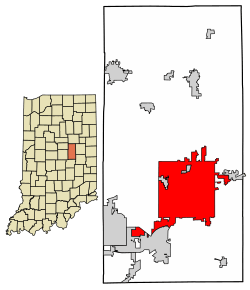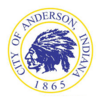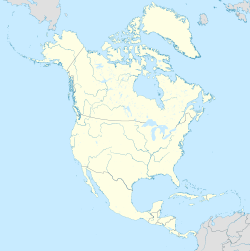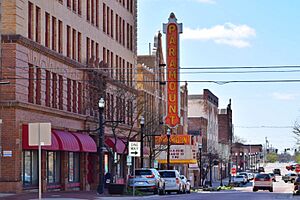Anderson, Indiana facts for kids
Quick facts for kids
Anderson, Indiana
|
||
|---|---|---|
|
Downtown Anderson
Paramount Theatre
Madison County Courthouse
Ascension (healthcare system)
Anderson Center for the Arts
|
||
|
||
| Nickname(s):
"Queen City of the Gas Belt"
|
||
| Motto(s):
Performance. Talent. Inspiration.
|
||

Location in Madison County, Indiana.
|
||
| Country | United States | |
| State | Indiana | |
| County | Madison | |
| Townships | Anderson (primarily) Adams, Fall Creek, Lafayette, Richland, Union (small sections) |
|
| Area | ||
| • Total | 41.71 sq mi (108.04 km2) | |
| • Land | 41.60 sq mi (107.74 km2) | |
| • Water | 0.11 sq mi (0.29 km2) | |
| Elevation | 863 ft (263 m) | |
| Population
(2020)
|
||
| • Total | 54,788 | |
| • Density | 1,317.08/sq mi (508.52/km2) | |
| Time zone | UTC−5 (EST) | |
| • Summer (DST) | UTC−4 (EDT) | |
| ZIP codes |
46011, 46012, 46013, 46016, 46017
|
|
| Area code | 765 | |
| FIPS code | 18-01468 | |
| GNIS ID | 2393952 | |
Anderson is a city in Madison County, Indiana, United States. It is also the county seat. In 2020, about 54,788 people lived there. The city is named after Chief William Anderson. He was a leader of the Lenape people.
Anderson is home to the world headquarters of the Church of God. It also has Anderson University. Some famous places in the city include the historic Paramount Theatre and the Gruenewald House.
Contents
History of Anderson
Early Days and Naming
Before Madison County was set up, William Conner bought the land where Anderson is now. He later sold it to John and Sarah Berry. They gave 32 acres of their land to Madison County. This was so the county seat could move from Pendleton to Anderson. John Berry officially planned the first part of Anderson on November 7, 1827. The county's main office moved to Anderson in 1828.
The city is named after Chief William "Adam" Anderson. His mother was Lenape and his father was from Sweden. Chief Anderson's Lenape name was Kikthawenund. This means "creaking boughs". The Lenape village was called "Anderson's Town". It was also known as "Andersonton" before it became the city of Anderson.
Growth and Challenges
In 1837, new building projects helped Anderson grow. The city was officially made a town in December 1838. It had 350 people then. A canal called the Central Canal was planned to go through Anderson. Work started in 1838 but stopped in 1839 because of money problems.
Anderson became a quiet village again. But in 1849, it was made a town for a second time. Many new shops opened near the courthouse. This lasted only a short time, and Anderson went back to being a village in 1852.
However, things changed when the Indianapolis Bellefontaine Railroad opened in 1852. Anderson started to grow fast. On June 9, 1853, Anderson became a town for the third time. Its population kept growing. On August 28, 1865, with almost 1,300 people, Anderson became a city.
The Gas Boom Era
Between 1853 and the late 1800s, many factories opened in Anderson. On March 31, 1887, natural gas was found in Anderson. This started the Indiana gas boom. New businesses, like glass-making, moved to the city to use the cheap gas. Anderson grew so much that a newspaper called it "The Pittsburgh on White River". It was also known as "Queen City of the Gas Belt".
In 1897, the Interurban Railroad started in Anderson. This was a new type of electric train. It connected cities and towns. The Interurban ran until 1941.
After the Gas Boom
In 1912, the natural gas ran out. The city had used too much gas, even leaving lights on all day and night. This caused many factories to leave Anderson. The city's growth slowed down.
A local club helped persuade some businesses to stay. For many years, Delco Remy and Guide Lamp were the biggest employers. During World War II, these factories made weapons for the Allies. From 1913 to the 1950s, the Ward-Stilson Company made uniforms and items for many groups.
The Church of God of Anderson moved its main office to Anderson in 1905. Anderson Bible School opened in 1917. It later became Anderson College in 1925. In 1988, it changed its name to Anderson University.
Many different types of automobiles were made in Anderson. The Lambert family was important in car development. Many other inventions came from Anderson. These include the gas regulator, the stamp vending machine, and a process to fix tires.
Anderson even had a professional basketball team. The Anderson Packers played in the National Basketball Association (NBA) for one season in 1949–50.
Like many factory cities, Anderson faced challenges in the 1970s and 1980s. Many jobs were lost when big companies like General Motors closed their operations. In the 1970s, almost 22,000 people worked for General Motors in Anderson. By 2006, this number was less than 2,600. Anderson has been working to recover from these job losses.
Geography of Anderson
Anderson is in the southern part of Madison County. It is located at 40°06′00″N 85°40′53″W / 40.100041°N 85.681525°W. The city covers most of Anderson Township. It also includes small parts of five other townships.
Indiana State Road 32 (14th Street) goes through the city center. It leads east to Muncie and west to Noblesville. Each city is about 19 miles (31 km) away. State Road 9 (Scatterfield Road) is on the east side of Anderson. It goes north to Alexandria (11 miles (18 km)) and southwest to Pendleton (10 miles (16 km)).
Interstate 69 runs through the southeast part of the city. You can get on I-69 from Exit 226 (SR 9/SR 109). I-69 goes southwest to Indianapolis (40 miles (64 km)) and northeast to Fort Wayne (83 miles (134 km)).
The U.S. Census Bureau says Anderson covers about 41.7 square miles (108.00 km2). Most of this area is land. Only a small part, about 0.1 square miles (0.3 km2), is water. The White River flows from east to west through the northern part of the city.
Climate in Anderson
| Climate data for Anderson(Sewage PLT)-2006-2020 normals | |||||||||||||
|---|---|---|---|---|---|---|---|---|---|---|---|---|---|
| Month | Jan | Feb | Mar | Apr | May | Jun | Jul | Aug | Sep | Oct | Nov | Dec | Year |
| Mean daily maximum °F (°C) | 35.4 (1.9) |
38.2 (3.4) |
50.8 (10.4) |
62.8 (17.1) |
73.3 (22.9) |
81.5 (27.5) |
83.9 (28.8) |
82.4 (28.0) |
76.9 (24.9) |
64.9 (18.3) |
50.9 (10.5) |
40.2 (4.6) |
61.8 (16.5) |
| Daily mean °F (°C) | 28.1 (−2.2) |
30.3 (−0.9) |
41.9 (5.5) |
52.4 (11.3) |
63.4 (17.4) |
71.9 (22.2) |
74.3 (23.5) |
72.8 (22.7) |
66.9 (19.4) |
55.2 (12.9) |
42.6 (5.9) |
33.3 (0.7) |
52.8 (11.5) |
| Mean daily minimum °F (°C) | 20.8 (−6.2) |
22.3 (−5.4) |
33.1 (0.6) |
42.1 (5.6) |
53.4 (11.9) |
62.2 (16.8) |
64.8 (18.2) |
63.3 (17.4) |
56.9 (13.8) |
45.4 (7.4) |
34.3 (1.3) |
26.4 (−3.1) |
43.8 (6.5) |
| Average precipitation inches (mm) | 2.79 (71) |
3.03 (77) |
4.15 (105) |
4.73 (120) |
4.38 (111) |
5.89 (150) |
3.94 (100) |
3.64 (92) |
2.92 (74) |
3.70 (94) |
3.57 (91) |
3.54 (90) |
46.28 (1,175) |
| Average snowfall inches (cm) | 7.0 (18) |
6.6 (17) |
1.6 (4.1) |
0.2 (0.51) |
trace | 0.0 (0.0) |
0.0 (0.0) |
0.0 (0.0) |
0.0 (0.0) |
trace | 0.4 (1.0) |
5.1 (13) |
20.9 (53.61) |
| Average extreme snow depth inches (cm) | 5 (13) |
4 (10) |
2 (5.1) |
0 (0) |
0 (0) |
0 (0) |
0 (0) |
0 (0) |
0 (0) |
0 (0) |
0 (0) |
4 (10) |
5 (13) |
| Average precipitation days (≥ 0.01 Inches) | 10 | 8 | 11 | 12 | 13 | 12 | 9 | 8 | 8 | 11 | 9 | 10 | 121 |
| Average snowy days (≥ 0.1 Inches) | 4 | 4 | 1 | 0 | 0 | 0 | 0 | 0 | 0 | 0 | 0 | 3 | 12 |
| Average relative humidity (%) | 71 | 68 | 67 | 65 | 67 | 68 | 69 | 68 | 64 | 65 | 70 | 73 | 68 |
| Mean monthly sunshine hours | 114.7 | 138.4 | 186 | 210 | 266.6 | 306 | 313.1 | 294.5 | 246 | 204.6 | 156 | 127.1 | 2,563 |
| Mean daily sunshine hours | 3.7 | 4.9 | 6 | 7 | 8.6 | 10.2 | 10.1 | 9.5 | 8.2 | 6.6 | 5.2 | 4.1 | 7.0 |
| Mean daily daylight hours | 9.7 | 10.7 | 12 | 13.3 | 14.4 | 15 | 14.7 | 13.7 | 12.4 | 11.1 | 10 | 9.4 | 12.2 |
| Average ultraviolet index | 2 | 2 | 3 | 4 | 5 | 6 | 6 | 6 | 4 | 2 | 2 | 2 | 4 |
| Source 1: NOAA NCEI National Weather Service(Snow-Precipitation days) | |||||||||||||
| Source 2: Weather Atlas(Sun-daylight-UV) climate data (Humidity) | |||||||||||||
| Climate data for Anderson, Indiana | |||||||||||||
|---|---|---|---|---|---|---|---|---|---|---|---|---|---|
| Month | Jan | Feb | Mar | Apr | May | Jun | Jul | Aug | Sep | Oct | Nov | Dec | Year |
| Record high °F (°C) | 69 (21) |
72 (22) |
85 (29) |
90 (32) |
96 (36) |
104 (40) |
105 (41) |
102 (39) |
103 (39) |
92 (33) |
81 (27) |
75 (24) |
105 (41) |
| Mean daily maximum °F (°C) | 32.3 (0.2) |
36.5 (2.5) |
48.1 (8.9) |
60.7 (15.9) |
71.6 (22.0) |
80.6 (27.0) |
83.7 (28.7) |
81.6 (27.6) |
75.7 (24.3) |
63.9 (17.7) |
50.4 (10.2) |
37.1 (2.8) |
60.2 (15.7) |
| Mean daily minimum °F (°C) | 17.4 (−8.1) |
20.9 (−6.2) |
31.5 (−0.3) |
40.3 (4.6) |
50 (10) |
59.3 (15.2) |
63.2 (17.3) |
61.1 (16.2) |
54.3 (12.4) |
43.1 (6.2) |
34.4 (1.3) |
23.5 (−4.7) |
41.6 (5.3) |
| Record low °F (°C) | −24 (−31) |
−19 (−28) |
−7 (−22) |
16 (−9) |
23 (−5) |
36 (2) |
42 (6) |
39 (4) |
26 (−3) |
15 (−9) |
−4 (−20) |
−22 (−30) |
−24 (−31) |
| Average rainfall inches (cm) | 2 (5.1) |
2.2 (5.6) |
3.5 (8.9) |
4 (10) |
3.8 (9.7) |
3.5 (8.9) |
4.1 (10) |
3.4 (8.6) |
3.1 (7.9) |
2.6 (6.6) |
3.3 (8.4) |
3.1 (7.9) |
38.6 (97.6) |
| Average snowfall inches (cm) | 6 (15) |
5.7 (14) |
2.3 (5.8) |
0.3 (0.76) |
0 (0) |
0 (0) |
0 (0) |
0 (0) |
0 (0) |
0 (0) |
0.8 (2.0) |
4.8 (12) |
19.2 (49) |
People in Anderson
| Historical population | |||
|---|---|---|---|
| Census | Pop. | %± | |
| 1850 | 383 | — | |
| 1860 | 1,196 | 212.3% | |
| 1870 | 3,126 | 161.4% | |
| 1880 | 4,126 | 32.0% | |
| 1890 | 10,741 | 160.3% | |
| 1900 | 20,178 | 87.9% | |
| 1910 | 22,476 | 11.4% | |
| 1920 | 29,767 | 32.4% | |
| 1930 | 39,804 | 33.7% | |
| 1940 | 41,572 | 4.4% | |
| 1950 | 46,820 | 12.6% | |
| 1960 | 49,061 | 4.8% | |
| 1970 | 70,787 | 44.3% | |
| 1980 | 64,695 | −8.6% | |
| 1990 | 59,459 | −8.1% | |
| 2000 | 59,734 | 0.5% | |
| 2010 | 56,129 | −6.0% | |
| 2020 | 54,788 | −2.4% | |
| Source: US Census Bureau | |||
2010 Census Information
In 2010, the city had a population density of about 1,356.8 inhabitants per square mile (523.9/km2) people per square mile. The average age in Anderson was 37.8 years old. About 22.4% of the people were under 18. About 16.3% were 65 or older. There were slightly more females (52.1%) than males (47.9%).
Anderson's Economy
When General Motors closed its factories in Anderson, it was a big challenge for the city. GM used to be the largest employer. In 2007, Forbes magazine listed Anderson as one of the "100 Best Places for Businesses" among smaller U.S. cities.
However, a report in 2014 noted that Anderson's job numbers had been going down for a long time. It also mentioned an increase in people needing food assistance. Recently, unemployment has improved, but it is still catching up to the rest of Indiana.
In 2013, the average household income in Anderson was $33,574. This was lower than the state average of $48,248. About 25.8% of the city's population lived below the poverty line. This was higher than the state average of 15.4%.
Here are the ten largest employers in Madison County as of February 2019:
| Rank | Employer | # of employees |
|---|---|---|
| 1 | Community Hospital Anderson | 1,980 |
| 2 | St. Vincent Health | 1,410 |
| 3 | Nestlé | 790 |
| 4 | Hoosier Park | 785 |
| 5 | Carter Express | 680 |
| 6 | Anderson University | 530 |
| 7 | Continuum | 500 |
| 8 | Kroger/Pay Less Super Markets | 440 |
| 9 | Greenville Technology Inc. | 395 |
| 10 | Walmart | 365 |
Places to Visit in Anderson
- Anderson Center for the Arts: A place for art, listed on the National Register of Historic Places.
- Anderson Speedway: A race track known for the Pay Less Little 500 and Redbud 400 races.
- Downtown Historic District: The historic center of the city.
- Hoosier Park Racing and Casino: A place for horse racing and games.
- Madison County Historical Center: Learn about the history of the county.
- Mounds State Park: A park next to the city with ancient earthworks.
- Paramount Theatre: A historic theater.
- Shadyside Memorial Park and Lake: A park with a lake.
- Other historic places on the National Register of Historic Places include:
- Anderson Bank Building
- Central Avenue School
- Gruenewald House
- Tower Hotel
- West Central Historic District
- West Eighth Street Historic District
Education in Anderson
Anderson has its own public school system called the Anderson Community School Corporation.
- It has one high school: Anderson High School (grades 9-12).
- One junior high school: Highland Middle School (grades 6-8).
- Six elementary schools: Eastside, Edgewood, Valley Grove, 10th Street, Erskine, and Anderson Elementary (grades K-5).
- A kindergarten center (Killbuck) and a preschool (Southview).
In 1997, Anderson High School moved into the old Madison Heights facility. In 2010, Highland High School became a junior high. All high school students now attend Anderson High School.
Anderson also has a charter school called Anderson Preparatory Academy. This is a free public school. It focuses on college preparation and military training. Students in grades 6-8 are part of the Civil Air Patrol. High school students are in the Air Force JROTC program.
Anderson University is in the city. There are also campuses for Ivy Tech Community College of Indiana and the Purdue Polytechnic Institute.
The city has a public library called the Anderson Public Library.
Famous People from Anderson
- Harold Achor, a judge for the Indiana Supreme Court
- Jermaine Allensworth, a professional baseball player
- Silas Allred, a college wrestler
- Lowell Amos, known for crimes
- Melvin E. Biddle, a World War II hero
- Don Brandon, a Hall of Fame baseball coach
- Jann Browne, a country music singer
- Gary Burton, a jazz musician
- Bob Carey, an Indy car driver
- Everett Case, a famous basketball coach
- Joshua Crockett, a university president
- Buck Crouse, a baseball catcher
- James Davis, a politician and former U.S. Secretary of Labor
- Winfield T. Durbin, a former governor of Indiana
- Cory Edwards, a producer and creator of internet series
- Carl Erskine, a professional baseball pitcher for the Dodgers
- Gordon Gordon, a crime novelist
- Krystal Harris, a singer
- Charles L. Henry, a politician who named the "interurban"
- Orville Hodge, known for financial crimes
- Gary Hoover, a businessman and author
- Robert Kessler, a college basketball player
- James Kilgore, a former activist
- John William Lambert, inventor of an early U.S. gasoline car
- Adam Lind, a professional baseball player
- Matt Lutz, an actor
- Von Mansfield, an NFL football player
- Brittany Mason, a model
- Mack Mattingly, a politician and senator
- Gary McGhee, a professional basketball player
- Jon McLaughlin, a singer
- Phyllis Reynolds Naylor, an author
- Phill Niblock, a composer and filmmaker
- Bruce Nickells, a horse racing driver and trainer
- Sandi Patty, a singer
- Amber Portwood, a TV personality
- James Rebhorn, an actor
- Kris Roe (The Ataris), a singer
- Kevin Stein, a poet
- Fred Mustard Stewart, an author
- Max Terhune, an actor
- Ray Tolbert, a basketball player for Indiana's 1981 NCAA championship team
- Greg Van Alst, a NASCAR driver
- Albert Henry Vestal, a politician
- Len Walston, a singer-songwriter
- Louis J. Weichmann, a witness in a famous trial
- Bob Wilkerson, a basketball player for Indiana's undefeated 1976 NCAA championship team
- Jumping Johnny Wilson, a basketball and baseball player
See also
 In Spanish: Anderson (Indiana) para niños
In Spanish: Anderson (Indiana) para niños












